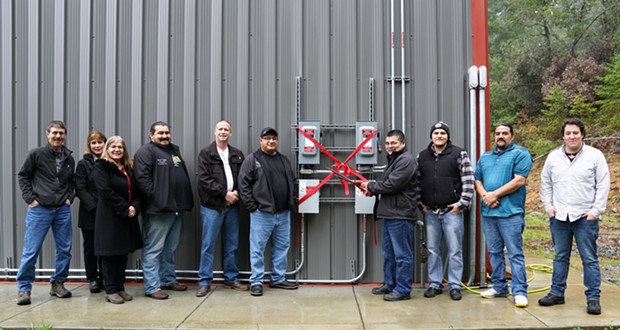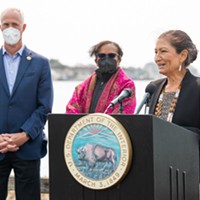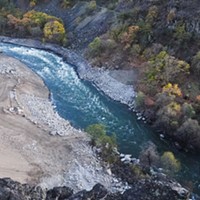Thursday, December 26, 2019
Yurok Tribe Celebrates Solar Power System
Posted By Kimberly Wear @kimberly_wear and Julie Cart, CalMatters on Thu, Dec 26, 2019 at 11:38 AM
The Yurok Tribe is celebrating the installation of a solar power system and has announced that another is being planned in an effort to bring electricity to the roughly 40 percent of families in the Weitchpec and Pecwan areas who do not have access to the grid.
According to a press release, the 28 kW photovoltaic system was grant funded and is a “first step” in fulfilling the Tribe’s energy vision, which seeks to ensure all members in Yurok Ancestral Territory “have access to reliable, affordable, modern, cost-effective energy services” and “promotes energy self-sufficiency, environmental sustainability, use of local renewable resources, job creation and economic opportunity.”
“To date, roughly 40 percent of the families living within the Weitchpec and Pecwan districts do not have access to grid electricity,” the release states. “Most of these residents get their electricity from gas or diesel-powered generators, which pose health risks for residents, pollute the environment and cost up to four times more than conventional grid electricity.”
The Yurok Tribe is also planning on installing a 24 kW photovoltaic system on the Tulley Creek Firehouse, the release states, and both projects were done in partnership with the Schatz Energy Research Center of Humboldt State University.
Likewise, the microgrid system of the Blue Lake Rancheria was build in collaboration with the Schatz center and proved to be an island of refuge during the Public Safety Power Shutdowns that darkened the region in October. With its grid keeping the power running, the Rancheria was not only able to keep its hotel open through the blackout, it also gassed up thousands of vehicles, distributed thousands of bags of ice and opened a community respite center that allowed people to charge their phones and medical devices.
Chris Marnay, a senior scientific fellow at Lawrence Berkeley National Laboratory, who wrote the definition of microgrid that is used by the U.S. Department of Energy, told CalMatters that these systems are going to be more and more important to California in the future. “California is a bit behind the curve,” Marnay said in the CalMatters article.
“The fires are going to be our Superstorm Sandy. They are going to bring about change.” Hurricane Sandy lashed the East Coast in 2012, leaving millions of customers in 21 states without power for days and weeks. The superstorm’s aftermath brought about policy changes in several states in the Northeast. Connecticut became the first in the country to create a statewide system of microgrids to provide emergency power.
Marnay and others noted that a microgrid research project kept operating after a magnitude 9.1 earthquake and tsunami devastated Japan in 2011 and knocked out power. The project, at a local university, performed well in the wake of the twin disasters, cementing the idea that independent power system scould maintain service in emergencies.
"It was a complete wake-up call,” Marnay said. “It woke up policymakers. The genie got out of the bottle, and (it) wasn’t just energy nerds such as myself interested in microgrids.” (Find the full CalMatters’ story on microgrids here.)
Read the full Yurok Tribe release below:
According to a press release, the 28 kW photovoltaic system was grant funded and is a “first step” in fulfilling the Tribe’s energy vision, which seeks to ensure all members in Yurok Ancestral Territory “have access to reliable, affordable, modern, cost-effective energy services” and “promotes energy self-sufficiency, environmental sustainability, use of local renewable resources, job creation and economic opportunity.”
“To date, roughly 40 percent of the families living within the Weitchpec and Pecwan districts do not have access to grid electricity,” the release states. “Most of these residents get their electricity from gas or diesel-powered generators, which pose health risks for residents, pollute the environment and cost up to four times more than conventional grid electricity.”
The Yurok Tribe is also planning on installing a 24 kW photovoltaic system on the Tulley Creek Firehouse, the release states, and both projects were done in partnership with the Schatz Energy Research Center of Humboldt State University.
Likewise, the microgrid system of the Blue Lake Rancheria was build in collaboration with the Schatz center and proved to be an island of refuge during the Public Safety Power Shutdowns that darkened the region in October. With its grid keeping the power running, the Rancheria was not only able to keep its hotel open through the blackout, it also gassed up thousands of vehicles, distributed thousands of bags of ice and opened a community respite center that allowed people to charge their phones and medical devices.
Chris Marnay, a senior scientific fellow at Lawrence Berkeley National Laboratory, who wrote the definition of microgrid that is used by the U.S. Department of Energy, told CalMatters that these systems are going to be more and more important to California in the future. “California is a bit behind the curve,” Marnay said in the CalMatters article.
“The fires are going to be our Superstorm Sandy. They are going to bring about change.” Hurricane Sandy lashed the East Coast in 2012, leaving millions of customers in 21 states without power for days and weeks. The superstorm’s aftermath brought about policy changes in several states in the Northeast. Connecticut became the first in the country to create a statewide system of microgrids to provide emergency power.
Marnay and others noted that a microgrid research project kept operating after a magnitude 9.1 earthquake and tsunami devastated Japan in 2011 and knocked out power. The project, at a local university, performed well in the wake of the twin disasters, cementing the idea that independent power system scould maintain service in emergencies.
"It was a complete wake-up call,” Marnay said. “It woke up policymakers. The genie got out of the bottle, and (it) wasn’t just energy nerds such as myself interested in microgrids.” (Find the full CalMatters’ story on microgrids here.)
Read the full Yurok Tribe release below:
(On Dec. 19,) the Yurok Tribe held a celebration commemorating the installation of a 28 kW photovoltaic system (solar panel system) on Tribe’s Transportation Building through a Tribal Solar Accelerator Fund Grant funded by GRID Alternatives and Wells Fargo.CALmatters.org, a nonprofit, nonpartisan media venture explaining California policies and politics, contributed to this report.
During the celebration the Tribe also announced plans to install a 24 kW photovoltaic system on the Tulley Creek Firehouse through the Cornerstone Grant funded by the Charitable Foundation of the Energy Bar Association. These projects, developed in partnership with the Schatz Energy Research Center of Humboldt State University, are significant and worth celebrating as they were the first projects identified in the Tribe’s newly created Strategic Energy Action Plan, and is also a first step in fulfilling the Tribe’s Energy Vision; which reads:
“To make sure all Tribal members living within the Yurok Ancestral Territory have access to reliable, affordable, modern, cost-effective energy services. In addition, the Tribe seeks an energy program that promotes energy self-sufficiency, environmental sustainability, use of local renewable resources, job creation, and economic opportunity for Tribal members.”
To date, roughly forty percent of the families living within the Weitchpec and Pecwan districts do not have access to grid electricity. Most of these residents get their electricity from gas or diesel-powered generators, which pose health risks for residents, pollute the environment, and cost up to four times more than conventional grid electricity.
Long-term, the Yurok Strategic Energy Action Plan outlines a strategy for the creation of a tribal energy program to provide residents with clean, affordable energy. The success of the Strategic Energy Action Plan has relied heavily on grant funding for initial project start-up costs. We would like to thank our funders and our partners for their help in implementing the first steps in the Tribe’s Energy Vision.
Speaking of...
Readers also liked…
More by Julie Cart, CalMatters
More by Kimberly Wear
-
Dust to Dust
The green burial movement looks to set down roots in Humboldt County
- Apr 11, 2024
-
Our Last Best Chance
- Apr 11, 2024
-
Judge Rules Arcata Can't Put Earth Flag on Top
- Apr 5, 2024
- More »



































